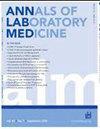Kogene PowerChek Multiplex Real-time PCR Kits Versus the BioFire FilmArray Gastrointestinal Panel: Roles of Crossing Point Values and Melting Curves in Interpreting the FilmArray Gastrointestinal Panel.
IF 3.9
2区 医学
Q1 MEDICAL LABORATORY TECHNOLOGY
引用次数: 0
Abstract
Background Various molecular methods are used to rapidly detect gastrointestinal pathogens, highlighting the importance of understanding the performance of the associated kits in detail. We comprehensively assessed the performance of Kogene PowerChek multiplex real-time PCR kits (PowerChek Bacterial/Viral Kits) with the FilmArray GI Panel. Methods Residual stool specimens (N=246), initially tested utilizing the FilmArray GI Panel (May 2023-Jan 2024), were reanalyzed using PowerChek Bacterial/Viral Kits. Discrepancies were resolved by performing additional molecular assays and reviewing culture results when available. True positives (TPs)/true negatives were defined by concordant results in at least two assays. We determined cycle threshold (Ct)/crossing point (Cp) distributions between the TP and false positive (FP) groups and analyzed melting curves for the FilmArray GI Panel FPs. Results The positive-percent agreement (PPA) of the PowerChek Bacterial/Viral Kits was 50-100%, with lower values for Salmonella spp., rotavirus, and astrovirus, whereas the FilmArray GI Panel showed 100% PPA across all targets. Both platforms demonstrated >99% negative-percent agreement, except for enteropathogenic Escherichia coli (EPEC) and adenovirus (PowerChek Bacterial/Viral Kits) or EPEC, enteroaggregative E. coli, norovirus, and Salmonella spp. (FilmArray GI Panel). The FPs showed higher Ct/Cp values with both kits, and these values were significantly higher for adenovirus (PowerChek Viral Kit), EPEC, and norovirus (FilmArray GI Panel). Melting curve analysis of four norovirus FPs (FilmArray GI Panel) revealed atypical patterns in three cases. Conclusions The FilmArray GI Panel demonstrated higher sensitivity than the PowerChek Kits. For norovirus, melting curve analysis will help avoid FPs.Kogene powercheck Multiplex Real-time PCR试剂盒与BioFire FilmArray胃肠道面板:交叉点值和熔化曲线在解释FilmArray胃肠道面板中的作用
各种分子方法用于快速检测胃肠道病原体,强调了详细了解相关试剂盒性能的重要性。我们使用FilmArray GI Panel综合评估了Kogene PowerChek多重实时PCR试剂盒(PowerChek细菌/病毒试剂盒)的性能。方法使用FilmArray GI Panel(2023年5月- 2024年1月)进行初步检测的残余粪便标本(N=246),使用PowerChek细菌/病毒试剂盒重新分析。差异通过进行额外的分子分析和检查培养结果来解决。真阳性(TPs)/真阴性由至少两次试验的一致结果定义。我们确定了TP组和假阳性组之间的循环阈值(Ct)/交叉点(Cp)分布,并分析了FilmArray GI Panel FPs的熔化曲线。结果powercheck细菌/病毒试剂盒的阳性率(PPA)为50-100%,对沙门氏菌、轮状病毒和星状病毒的阳性率较低,而FilmArray GI Panel对所有靶标的阳性率为100%。除了肠致病性大肠杆菌(EPEC)和腺病毒(powercheck细菌/病毒试剂盒)或EPEC、肠聚集性大肠杆菌、诺如病毒和沙门氏菌(FilmArray GI Panel)外,这两个平台均显示出99%阴性的一致性。两种试剂盒的FPs均显示较高的Ct/Cp值,并且腺病毒(powercheck病毒试剂盒)、EPEC和诺如病毒(FilmArray GI Panel)的这些值显著较高。4例诺如病毒FPs的熔化曲线分析(FilmArray GI Panel)显示3例不典型。结论FilmArray GI Panel比PowerChek Kits具有更高的灵敏度。对于诺如病毒,熔化曲线分析有助于避免FPs。
本文章由计算机程序翻译,如有差异,请以英文原文为准。
求助全文
约1分钟内获得全文
求助全文
来源期刊

Annals of Laboratory Medicine
MEDICAL LABORATORY TECHNOLOGY-
CiteScore
8.30
自引率
12.20%
发文量
100
审稿时长
6-12 weeks
期刊介绍:
Annals of Laboratory Medicine is the official journal of Korean Society for Laboratory Medicine. The journal title has been recently changed from the Korean Journal of Laboratory Medicine (ISSN, 1598-6535) from the January issue of 2012. The JCR 2017 Impact factor of Ann Lab Med was 1.916.
 求助内容:
求助内容: 应助结果提醒方式:
应助结果提醒方式:


